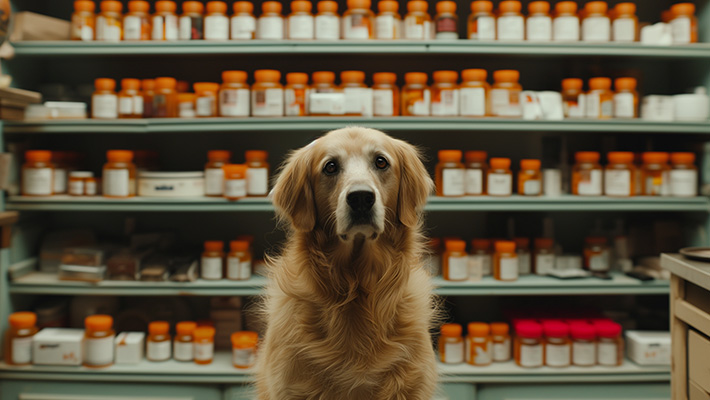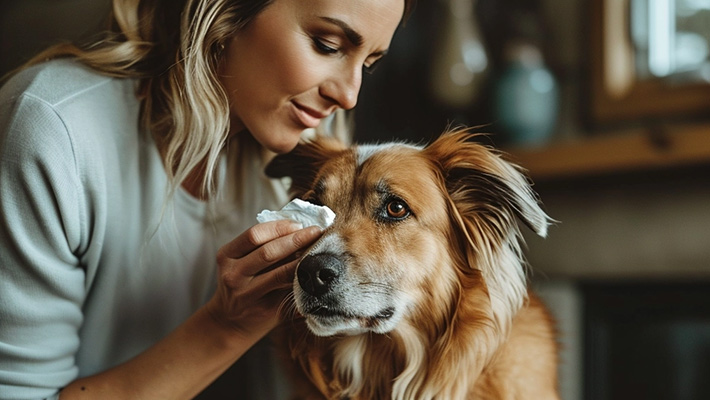A Guide To Claritin for Dogs: Dosage, Safety And Side Effects


Have you ever wondered if you can give your pup Claritin when his allergies are going haywire? Your furry friend is constantly scratching and licking his paws, and his eyes look sad and itchy. The poor guy can’t get comfortable. But before you raid your medicine cabinet, let’s talk about whether Claritin is safe for dogs.
In this article, we’ll cover everything you need to know about using Claritin to ease your pup’s allergies. We’ll discuss dosages, potential side effects, safety precautions, and more. With the info here, you’ll be able to decide if Claritin is the right allergy medication for your dog. Let’s dig in and get your pup some relief!
What Is Claritin?

Claritin is an over-the-counter antihistamine used to relieve allergy symptoms in dogs. The generic name for Claritin is loratadine. It works by blocking the effects of histamine in the body, which can cause an allergic reaction.
How It Works
When a dog has an allergic reaction, their body releases histamine. Histamine is a type of chemical that causes inflammation and allergy symptoms in the cells and leads to common allergy symptoms like itching, sneezing, and scratching.
Histamine is released by the immune system when it detects a foreign substance, such as pollen, dust, or animal dander. Claritin works by preventing histamine from binding to certain cells called H1 receptors. By preventing histamine from attaching to its receptors, Claritin reduces the inflammation and irritation that histamine causes.
Is Claritin Safe For Dogs?

Claritin is typically very safe for most dogs when given properly and according to the label. But there are some exceptions and precautions. This drug should not be given to dogs with liver or kidney disease or to pregnant or lactating dogs.
Moreover, Claritin may also interact with other drugs or supplements that your dog is taking. So, you should always let your vet know about any other medications your dog is on to check for potential drug interactions.
If you are giving claritin to your dog for the first time, keep them under careful observation for some time. In case they experience any severe or unusual side effects while taking Claritin, contact your vet immediately. They can determine if Claritin is safe and appropriate for your dog or if an alternative treatment may need to be explored.
But overall, when given properly according to your vet’s directions, Claritin is a very safe medication for relieving allergy symptoms in most dogs.
Safe Dosages Of Claritin For Dogs

The safe and appropriate dose of claritin for dogs depends on several factors, such as the type and severity of allergy, the dog’s weight, and existing medical conditions.
For most dogs, the typical dosage of Claritin is 1 mg of loratadine per pound of body weight, given once a day. So, if you have a 20-pound dog, a safe dosage to start with would be around 20 mg of Claritin per day.
You can then adjust the dosage up or down based on your dog’s response and any side effects. You can also go through the claritin for dogs dosage chart for a better understanding:
| Type of Breed | Appropriate Dosage |
| For small breeds (less than 15 lbs) | One 5 mg tablet once a day |
| For medium-sized breeds (15 – 40 lbs) | Two 5 mg tablets twice a day or one 10 mg tablet once a day |
| For large breeds (over 40 lbs) | One 10 mg tablet twice a day. |
Claritin can be given to dogs with or without food, but it may be easier to give it with a small treat or a spoonful of peanut butter to mask the taste and ensure proper swallowing. In case you miss a dosage of Claritin, you can administer it to your dog as soon as possible. Or you can just skip it and continue giving the medicine according to the regular schedule starting the next day.
What Are The Different Forms Of Claritin For Dogs Available In The Market?
Claritin for dogs is available in the following forms:
- Oral tablets: These are swallowed whole with water and come in 10 mg strength.
- Oral capsules: These are also swallowed whole with water and come in 10 mg strength.
- Oral disintegrating tablets (ODTs): These are placed on the tongue and dissolve quickly without water. They come in 5 mg and 10 mg strength and are also known as Claritin RediTabs.
- Chewable tablets: These are chewed before swallowing and come in 5 mg and 10 mg strength. They are available in grape and bubblegum flavors for children.
- Oral liquid: This is a syrup that is measured with a dosing syringe or spoon and swallowed. It comes in 5 mg/5 mL strength.
Claritin should be given in the appropriate form and strength for dogs. Do not give your dog Claritin-D, which contains pseudoephedrine, a decongestant that is highly toxic to dogs.
Moreover, oral disintegrating loratadine tablets (also called “orodispersible” tablets) may contain xylitol, a sweetener that is toxic to dogs and should not be used in dogs. So, always check the label and ingredients of any Claritin product before giving it to your dog.
How Long Can I Give My Dog Claritin?
You can give Claritin for dogs for extended periods to control symptoms during allergy season or year-round, as directed by your vet. However, you should not give Claritin for more than 14 days in a row without consulting your vet.
They may want to evaluate your dog to determine if an alternative treatment is needed. Always follow the dosage and administration directions from your vet to ensure it remains safe and effective for your dog long-term.
Potential Side Effects Of Giving Claritin To Dogs

While Claritin is generally safe for most dogs, some may experience side effects, especially when first starting the medication or if the dosage is too high. Monitor your dog closely after giving Claritin to watch for any negative reactions.
Some of the common side effect are given below:
Gastrointestinal Upset
Some dogs may experience mild nausea, vomiting, or diarrhea when first taking Claritin or if the dosage is increased too quickly. To avoid this, start with a low dose and gradually increase to the recommended amount for your dog’s size. Make sure your dog stays hydrated if any Gl upset occurs. If symptoms persist for more than a day or two, consult your vet.
Drowsiness or Hyperactivity
Claritin can have a paradoxical effect in some dogs, causing either drowsiness or hyperactivity. The drowsiness tends to go away once your dog adjusts to the medication but may recur each time the dosage is increased. Hyperactivity may require a dosage adjustment or switching to a different medication.
Skin Reactions
Rarely, dogs may experience itching, hives, or other skin reactions to Claritin. Antihistamines, after all, work by blocking histamine receptors, which can lead to adverse skin effects in some dogs. See a vet immediately if your dog develops any swelling of the face or hives. An alternative treatment may be needed.
While the side effects of Claritin tend to be mild most of the time, it’s always a good idea to consult your vet if your dog experiences any unusual symptoms after starting this or any new medication.
They can evaluate whether Claritin is still a good choice for your dog or if an alternative treatment may be better tolerated. Close monitoring, especially when first starting Claritin or increasing the dosage, will help ensure your dog remains as comfortable and healthy as possible.
Safer Alternative To Claritin For Dogs

If your vet advises against giving your dog Claritin, then you can consider any one of the safer alternatives to Claritin for dogs given below:
Chlorpheniramine: Also known as Chlor-Trimeton, it is a first-generation antihistamine that is prescribed for allergic skin diseases in dogs. Although the FDA has not yet approved it for use in animals, it is considered very safe for most dogs. Veterinarians often prescribe this as an off-label treatment.
It can be found over the counter. The typical dosage for dogs is 2 to 4 mg per dose, two to three times a day. But as with any medication, you’ll want to check with your vet first on the proper dosage for your dog based on size and breed.
Benadryl (diphenhydramine): This is a first-generation antihistamine that can reduce itching, sneezing, and inflammation in dogs. It can also cause drowsiness, which may be beneficial for anxious dogs. The usual dose of Benadryl is 1 mg per pound of body weight, given 2-3 times a day.
Zyrtec (cetirizine): This is another second-generation antihistamine that can help with skin allergies and atopic dermatitis in dogs. It is less likely to cause drowsiness than Benadryl but may still have some sedative effects. The usual dose is 0.5 mg per pound of body weight, given once a day.
Common Allergies In Dogs

Now that you have learned about some of the allergy medicines for dogs let’s take a look at some of the common allergies that dogs suffer from:
Flea allergies: This is an allergic reaction to the saliva of fleas that bite the dog, causing intense itching, hair loss, scabs, and skin infections. The best way to prevent and treat flea allergies is to use effective flea control products and keep the dog’s environment clean.
Environmental allergies: This is an allergic reaction to substances in the environment, such as pollen, dust, mold, or mites, that the dog inhales or contacts with its skin. The symptoms include sneezing, coughing, runny eyes, itching, and skin inflammation. The treatment may involve avoiding allergens, using antihistamines, steroids, or immunotherapy.
Food allergies: This is an allergic reaction to certain ingredients in the dog’s food, such as beef, chicken, dairy, or grains. The symptoms include itching, ear infections, vomiting, diarrhea, and weight loss. The treatment involves identifying and eliminating the offending food from the dog’s diet and using hypoallergenic or novel protein diets.
Contact allergies: This is an allergic reaction to substances that touch the dog’s skin, such as plants, fabrics, or chemicals. The symptoms include redness, swelling, itching, and blisters on the contact area. The treatment involves avoiding the allergens, washing the affected area, and using topical creams or ointments.
Atopic dermatitis: This is a genetic condition that makes the dog more prone to environmental allergies, especially to dust mites. The symptoms include chronic itching, licking, chewing, and rubbing of the face, feet, armpits, and groin. The treatment may involve using antihistamines, steroids, immunotherapy, or cyclosporine.
How Can I Prevent My Dogs From Getting Allergies?
Allergies can significantly affect your dog’s quality of life. But the saddest part is that there is no sure way to prevent your dog from getting allergies. This is because allergies are mostly inherited or triggered by environmental factors.
However, there are some steps that you can take to reduce your dog’s exposure to allergens. These are as follows:
Wipe down your dog after walks: Use pet grooming wipes or a damp cloth to remove pollen, dust, and other allergens from your dog’s fur, paws, and skin after outdoor activities.
Bathe your dog regularly: During allergy season, use a hypoallergenic dog shampoo to wash away allergens and soothe your dog’s skin. You can also add oatmeal or baking soda to the water for extra relief.
Use supplements: Omega-3 fatty acids, biotin, and probiotics can help boost your dog’s skin health and immune system and reduce inflammation and itching. Consult with your veterinarian before giving any supplements to your dog.
Avoid potential triggers: Identify and eliminate any substances that may cause allergic reactions in your dog, such as certain foods, plants, fabrics, or chemicals. You can also use air filters, vacuum cleaners, and humidifiers to improve the air quality in your home.
In A Nutshell
So that’s the lowdown on Claritin for dogs – how it works, dosage info, safety precautions, and potential side effects. While it can provide relief for your pup’s allergy symptoms, it’s important to follow your vet’s guidance.
Don’t just grab a Claritin from your medicine cabinet and pop it in your dog’s mouth! These meds are formulated for humans, not canines. Work with your vet to find the right allergy med and dosage for your furry friend. With the proper treatment, you’ll both be able to breathe easy this allergy season.








All Comments
Rivel
12 May, 2024
Thanks for sharing excellent informations. Your web site is so cool. I'm impressed by the details that you have on this web site. It reveals how nicely you perceive this subject. Bookmarked this website page, will come back for more articles. You, my pal, ROCK! I found simply the information I already searched everywhere and just couldn't come across. What a great web-site.
Reply
25 May, 2024
Thank you, I have recently been looking for information about this subject for ages and yours is the best I have discovered till now.
Reply